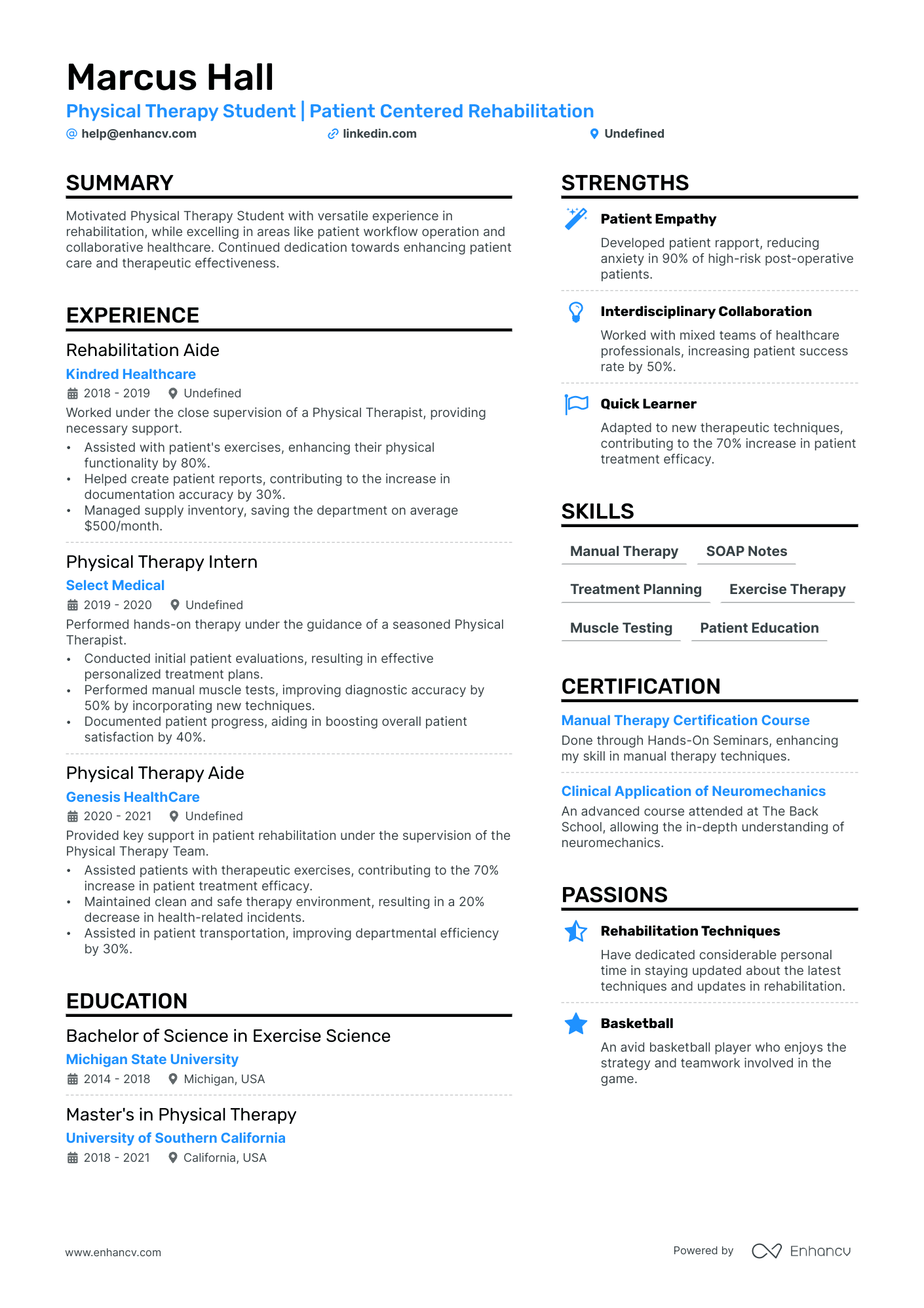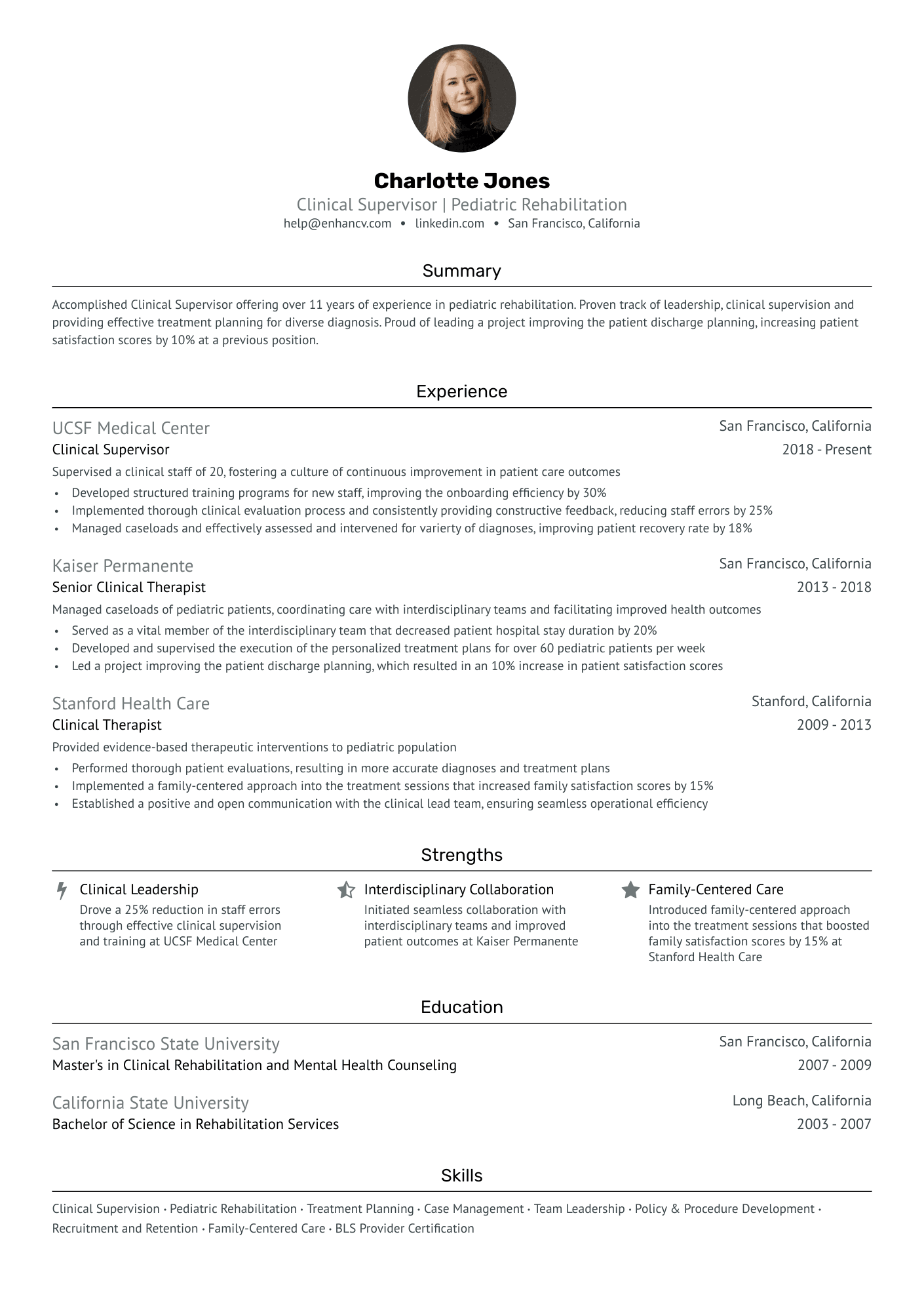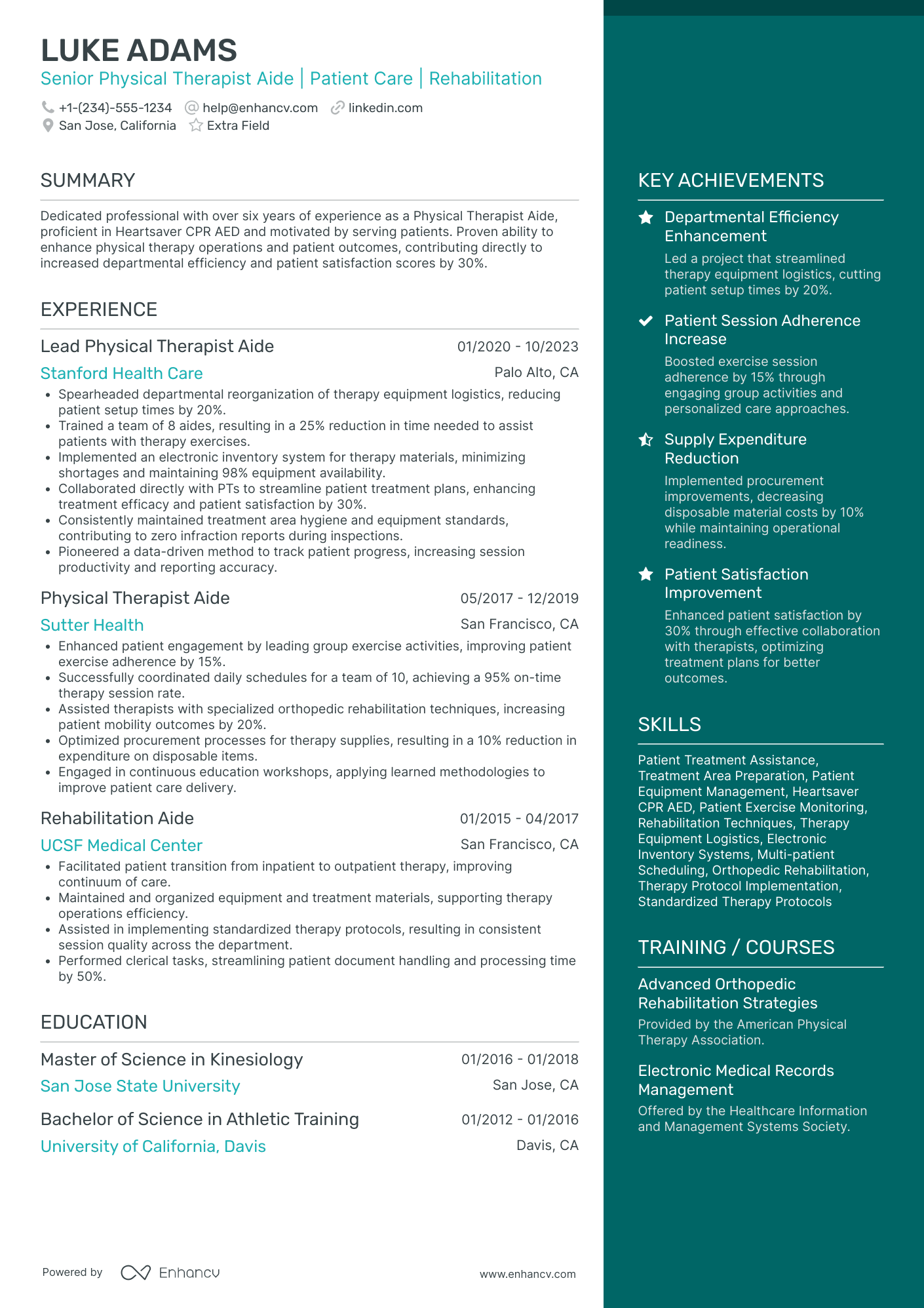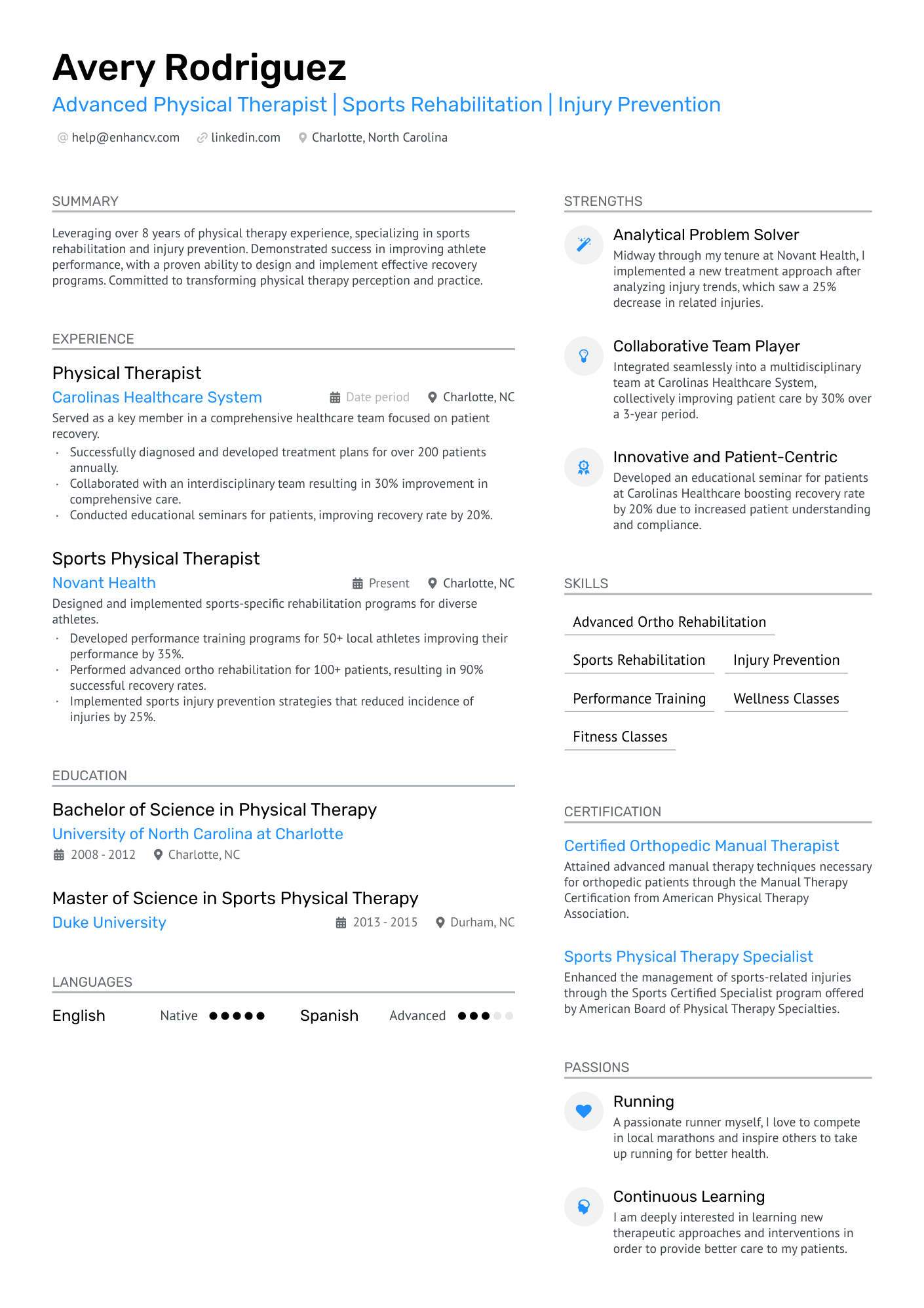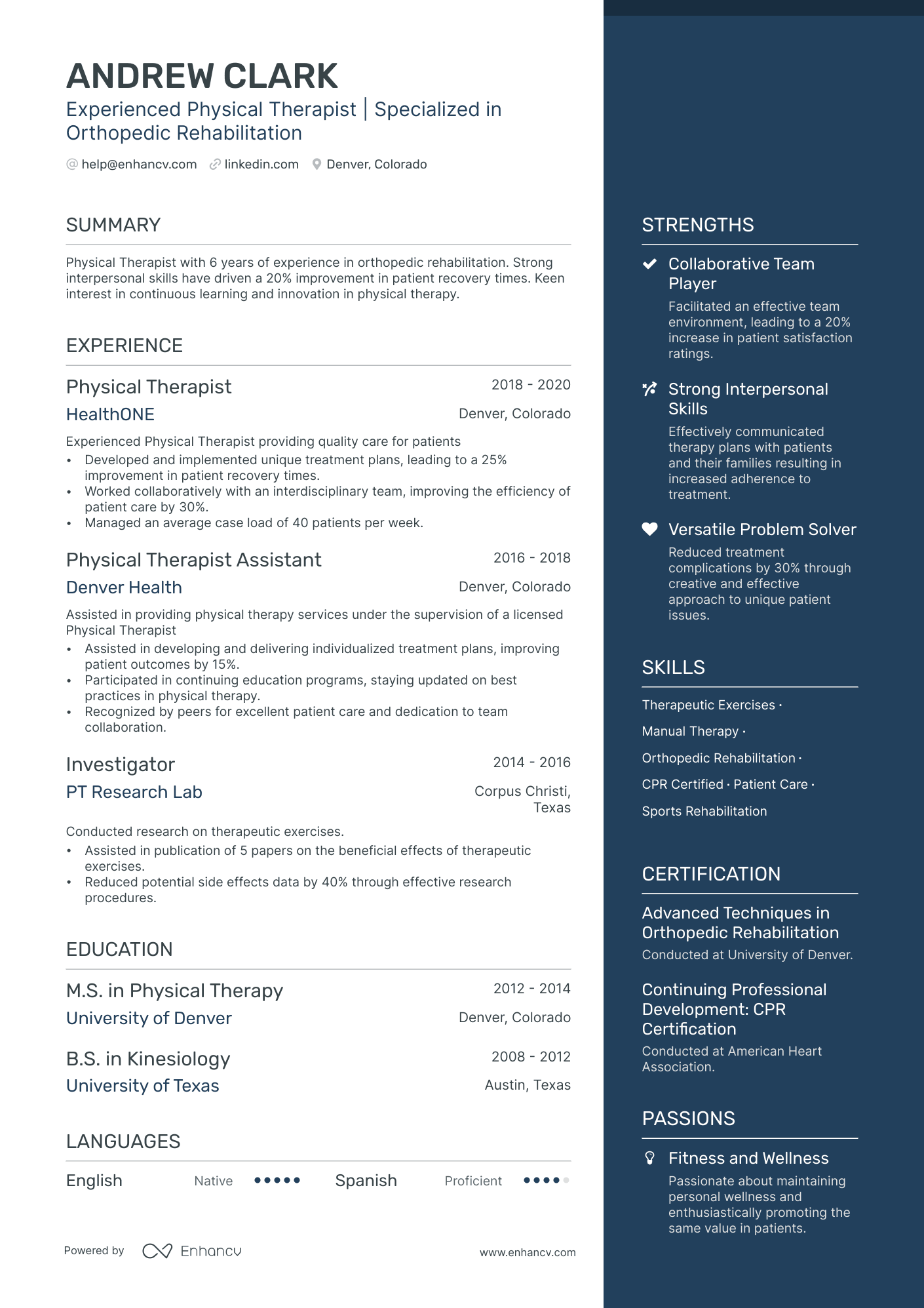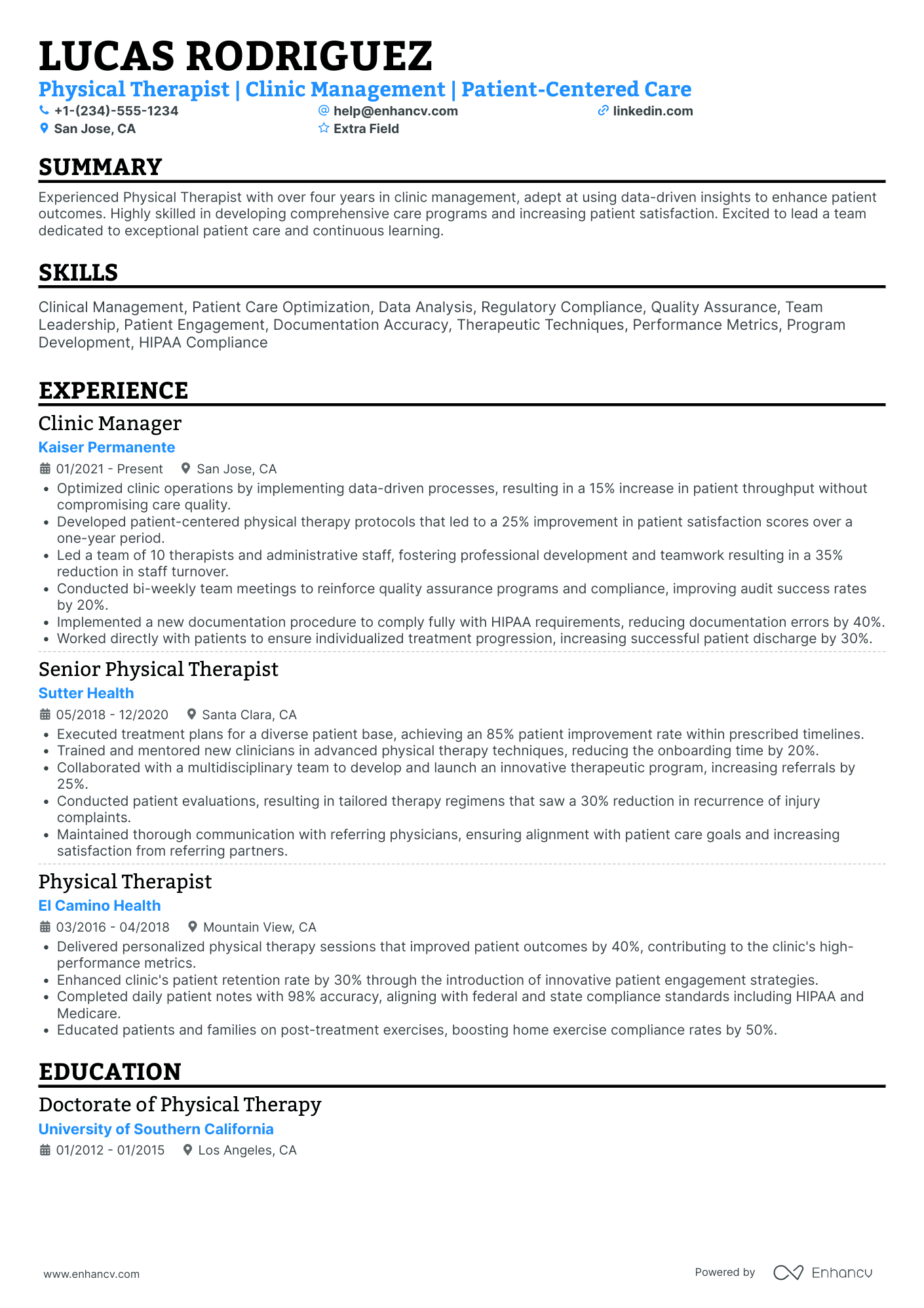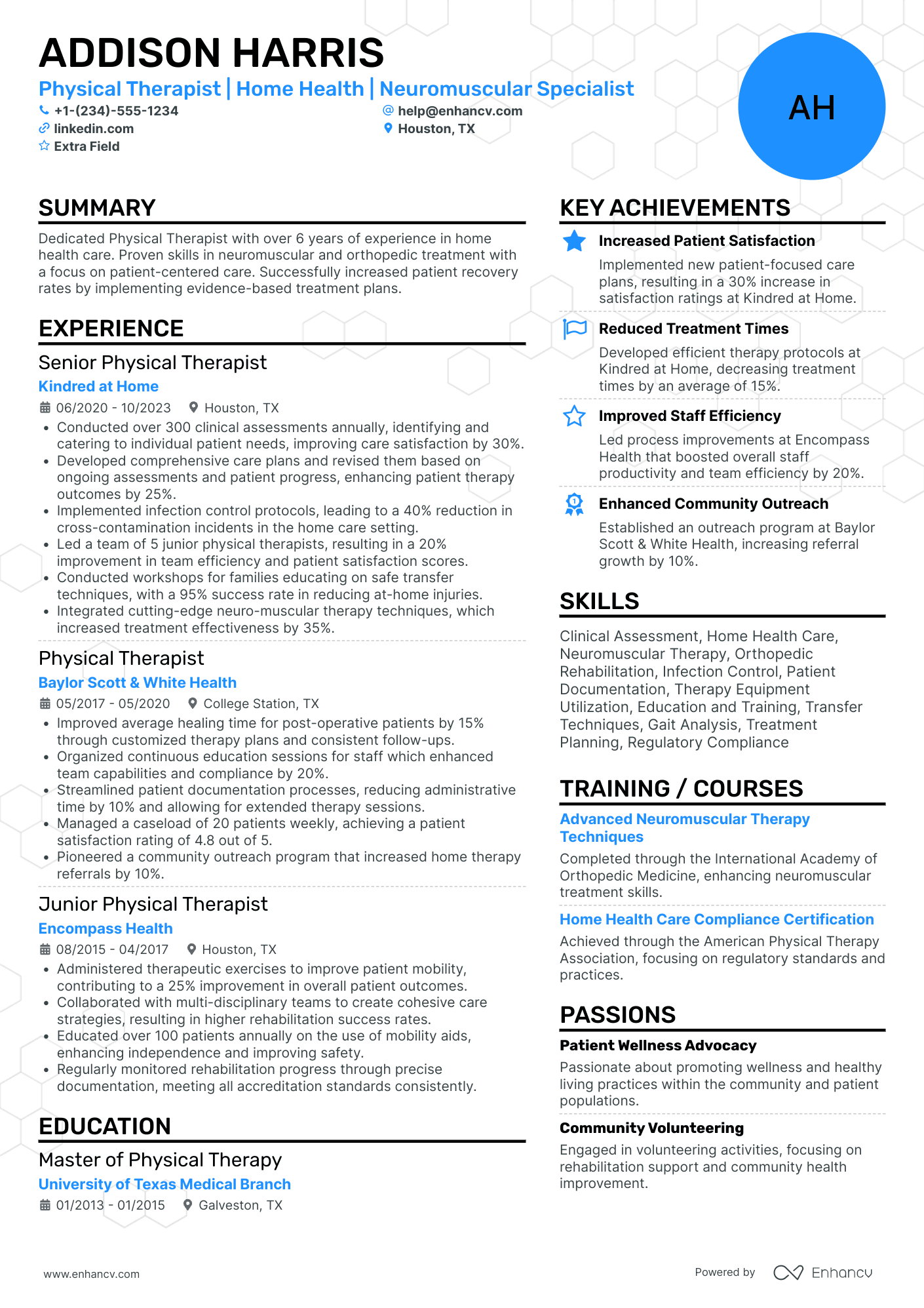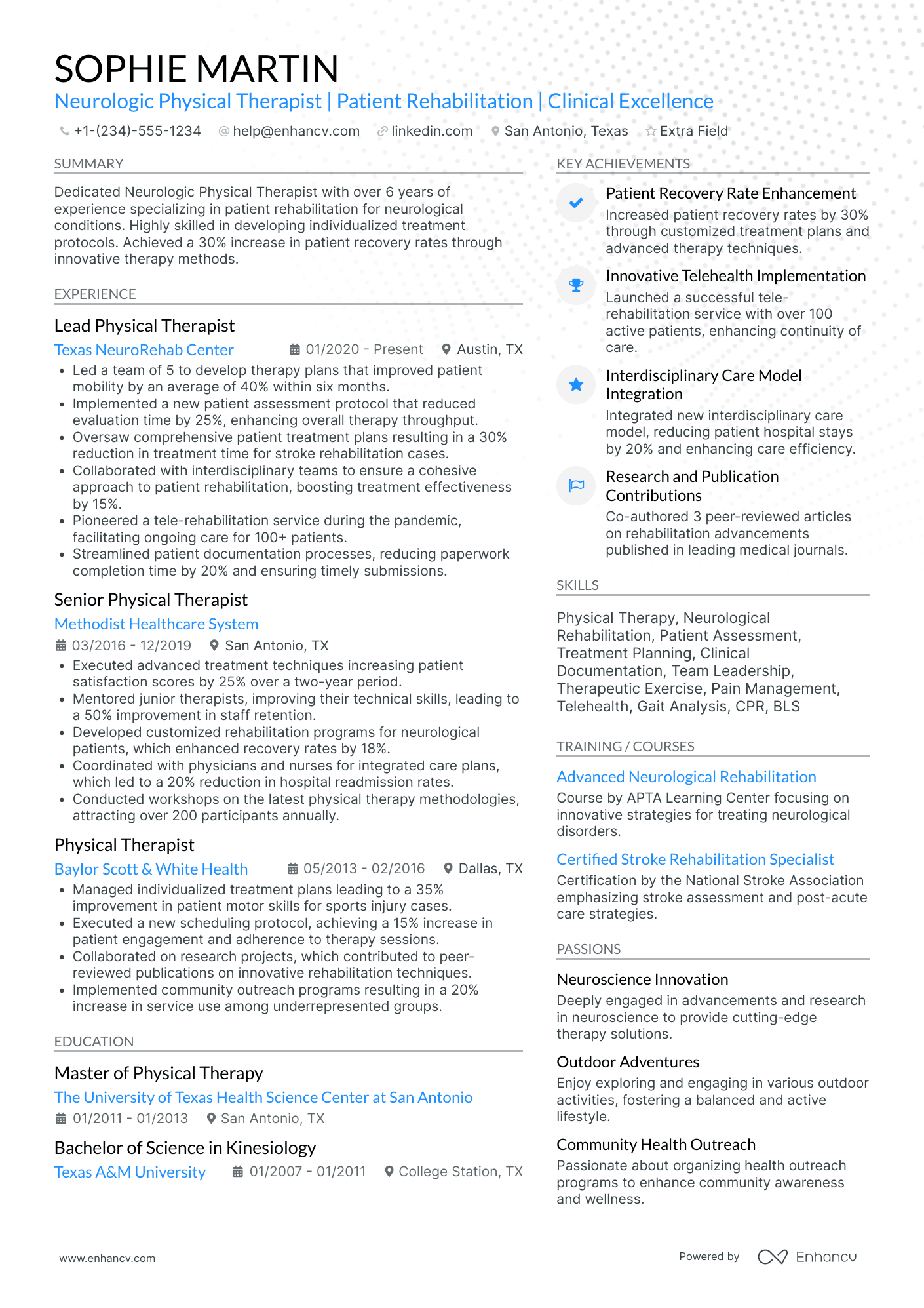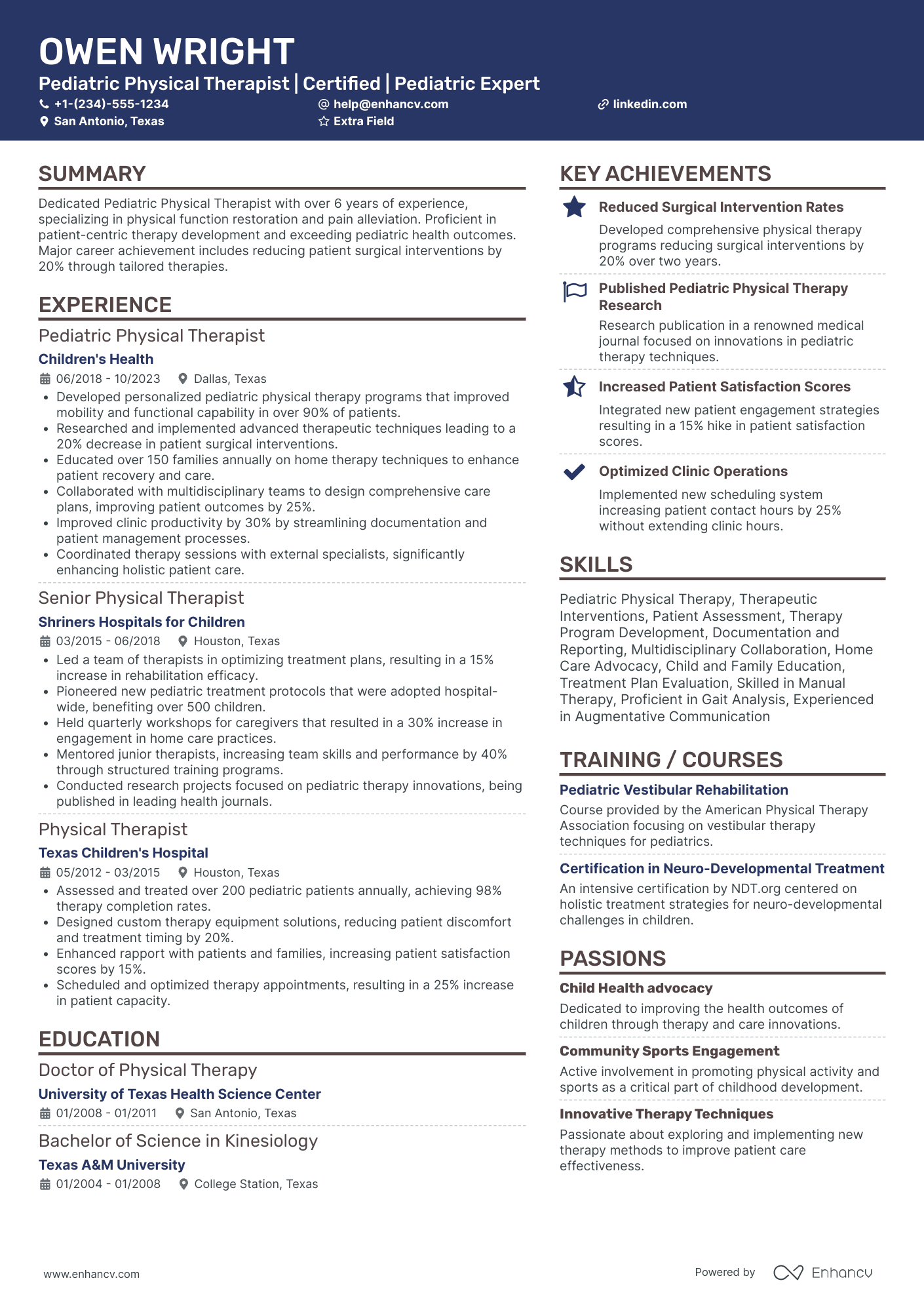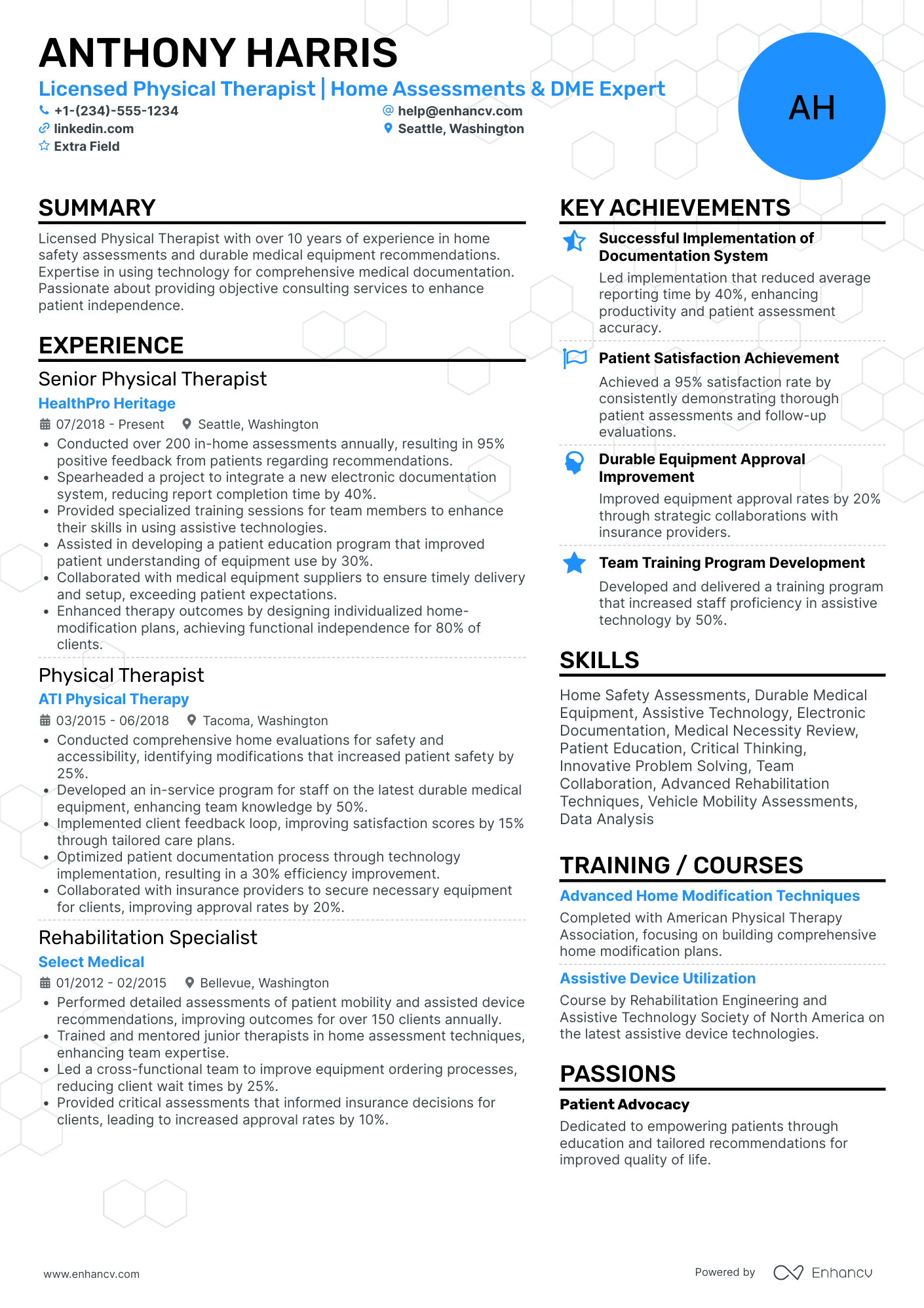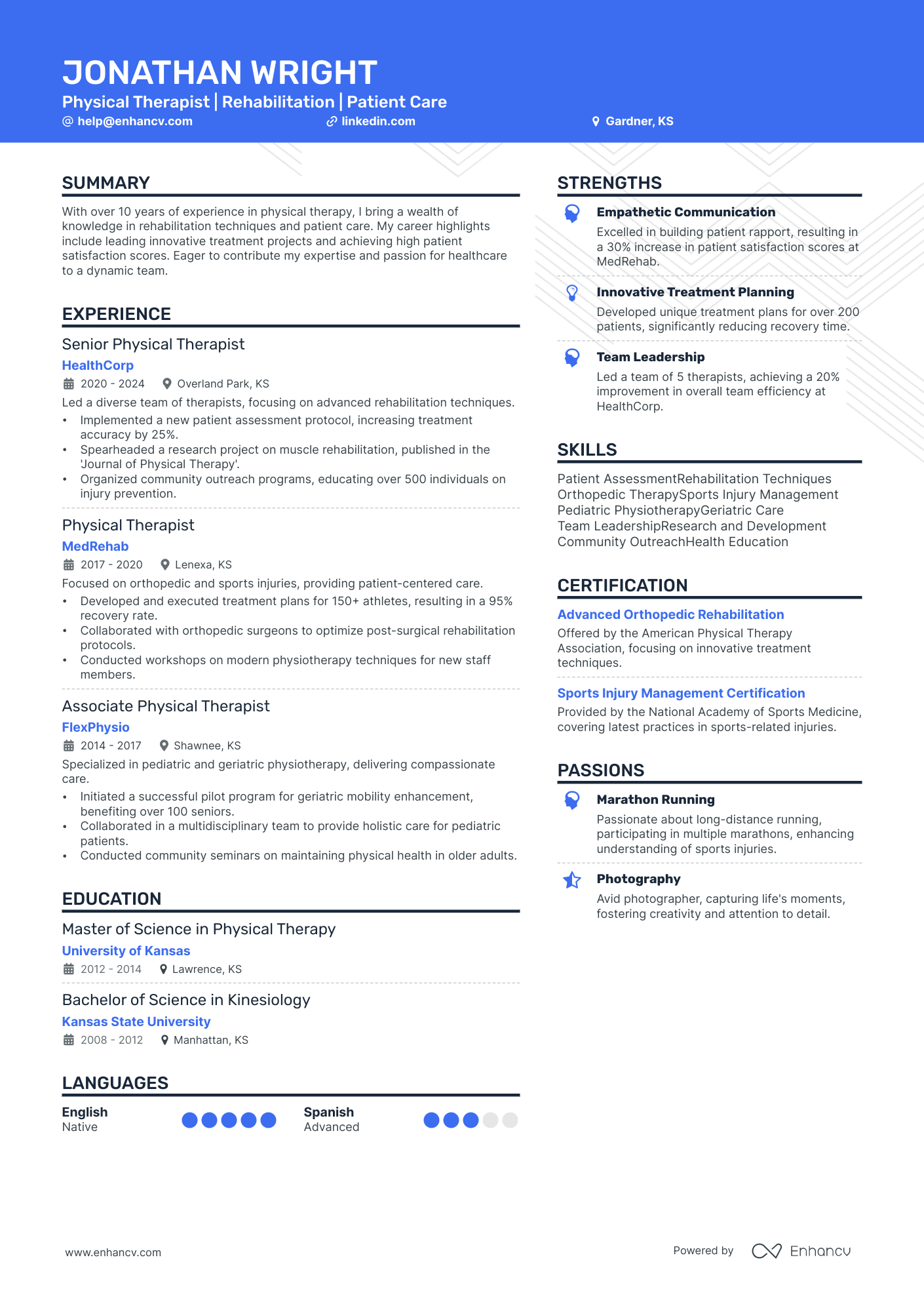As a physical therapist, you have a wide range of important skills.
From patient care to anatomical knowledge, you have to juggle active hands-on work with patients alongside significant administrative tasks and record-keeping.
Clearly outlining this diverse skillset on a physical therapist's resume can be a daunting task.
In this guide, you’ll learn:
- How to highlight professional achievements so that recruiters take notice
- How to organize your experience section to showcase your commitment to physical therapy
- How to strike the right balance of soft skills and hard skills to demonstrate expertise in the field
- How to present relevant certifications to increase your employability
If a physical therapist resume isn’t exactly what you’re looking for, browse our guides for similar roles:
- Physical therapist assistant resume
- Physical therapy student resume
- Massage therapist resume
- Therapist resume
- Occupational therapist resume
- Physical therapist cover letter
Physical therapist resume example
Here's what this applicant does well in their resume:
- Highlighting professional achievements: Demonstrates impact through specific outcomes, such as increasing treatment accuracy and leading successful projects.
- Emphasizing relevant experience: Focuses on roles and responsibilities directly related to physical therapy, showcasing a clear career trajectory in the field.
- Showcasing certifications: Includes relevant certifications like Advanced Orthopedic Rehabilitation and Sports Injury Management, which are highly pertinent to the physical therapy field.
- Detailing educational background: Clearly outlines educational qualifications, including a Master's in Physical Therapy and a Bachelor's in Kinesiology, which are foundational for the role.
How to format a physical therapist resume
physical therapists need to clearly demonstrate job-specific skills and educational qualifications.
Send a clear message of your expertise with an organized and professional resume format. It’s the first thing hiring managers notice and your first opportunity to make a good impression.
Here are a few areas to focus on for a physical therapist resume format that recruiters look for:
- Reverse chronological layout - As the name suggests, a reverse chronological layout focuses on work experience in reverse chronological order. Patient success stories are key for a physical therapist. Show your commitment to your patients with a strong work history.
- Professional header - Include a header at the top of your resume that clearly states your title and professional contact information. Physical therapists can have credentials in specialized areas. Show your qualifications right away by introducing yourself with a header.
- Single page - Potential employers will have tons of applications to sort through. Save them time by keeping every section of your resume short, concise, and relevant to your physical therapy achievements.
- ATS optimized - Select fonts, keywords, and file formats that are optimized for Applicant Tracking Systems. Use ATS-friendly fonts like Rubik and Montserrat and a PDF file format in Enhancv’s resume builder to give your physical therapist's resume the best chance of making it to a human recruiter.
Different regions expect different formats – Canadian resumes, for example, may look unique.
Is your resume good enough?
Drop your resume here or choose a file. PDF & DOCX only. Max 2MB file size.
The top sections on a physical therapist resume:
- Contact information: Essential so that recruiters can reach out for interviews or further clarification.
- Objective statement: This section gives the recruiter insight into your career goals and how they align with the physical therapy profession.
- License and certification: Especially important for physical therapists as it showcases your qualifications and legal standing in practice.
- Education and training: Recruiters need to know your educational background and any additional training relevant to physical therapy.
- Clinical experience: This section highlights your practical experience in the field, showing recruiters your competence and familiarity with the role.
What recruiters want to see on your resume:
- Clinical experience: Recruiters prioritize this as it demonstrates the candidate's practical skills and familiarity with patients' needs within the context of physical therapy.
- Certification and licensing: This is critical as it reassures the recruiter of the candidate's competency and legal status to practice physical therapy.
- Specialization areas: Recruiters look for candidates who have specialized in certain areas of physical therapy, such as geriatrics or sports, to fulfill specific demands of the role.
- Communication skills: physical therapists need to have excellent communication skills as they consistently interact with patients, other health professionals, and possibly the patients' family members. Recruiters prioritize this to ensure smooth operation within their teams.
- Continuing education: Recruiters prioritize candidates who show a commitment to furthering their knowledge and skills. It illustrates their commitment to their profession and their dedication to providing the best care possible.
How to write your physical therapist resume experience
The experience section of your resume lists your work history along with 3-4 bullets highlighting your top accomplishments in the role. Show potential employers what you’ve achieved as a physical therapist so they can see how you’ll impact success at their organization.
Hiring managers don’t just want to see a list of roles and responsibilities. Highlight patient success stories and industry achievements to show what makes you the right candidate.
Let’s look at an example of a physical therapist's resume experience section.
- •Assessed and treated patients
- •Built strong relationships with clients
- •Proficient in electronic health records software
What doesn’t work in this example:
- No quantifiable results - “Assessed and treated patients” is an example of job duties, but makes no mention of whether the candidate was successful. Quantify achievements on your physical therapist resume with measurable results.
- No evidence to claims - Saying “Built strong relationships with clients” is expecting recruiters to just take your word for it. Demonstrate strong use of skills with clear examples and achievements.
- No industry keywords - Claiming proficiency in “electronic health records software” misses an opportunity to use job-specific keywords and industry skills.
Let’s make a few improvements and take another look.
- •Assessed and treated 150 patients, resulting in a 95% recovery rate
- •Received Client Favorite Award in 2021 for customer service and patient success
- •Managed 200 patients in WebPT and Therabill
What works in this example:
- Quantifies success - Using real numbers and metrics in your resume like “Assessed and treated 150 patients, resulting in a 95% recovery rate” shows potential employers how you will achieve success in your role.
- Highlights industry achievements - Industry awards like the “Client Favorite Award” can be a great way to show accomplishments and expertise in the field.
- Uses industry keywords - Mentioning keywords like WebPT and Therabill shows knowledge of physical therapy software tools and optimizes your resume for ATS filters.
How to quantify the impact on your physical therapist's resume
Don’t expect potential employers to just take your word for it when claiming success. Quantify the impact on your physical therapist resume with measurable results.
For a physical therapist, the best measure of success is the progress and well-being of their patients.
However, quantifying this progress for a resume can be challenging, especially considering privacy laws like the Health Insurance Portability and Accountability Act (HIPAA) that limit what information can be shared.
Here is a list of areas to consider when using real numbers and data on your physical therapist resume to emphasize your impact:
- Include the number of patients you treat on a daily or weekly basis: This shows the recruiter your ability to manage your workload effectively.
- Mention the types and volumes of conditions you handle: This provides recruiters with a clear view of your expertise and diversity of skills.
- Specify the number of rehabilitation programs you've designed or led: This reflects your leadership skills and clinical knowledge.
- Highlight the number of team projects or initiatives you've been involved in: This underlines your teamwork skills and collaboration capabilities.
- State the percentage of patients who reported improvement under your care: This highlights your effectiveness as a physical therapist.
- List the number of continuing education or professional development classes you've taken: This demonstrates your commitment to staying updated in your field.
- Indicate the amount of equipment or budget you were responsible for: This shows your ability to handle resources efficiently, which is a critical business skill.
- Report any rating scores received from patient reviews: This shows the recruiter your ability to meet and exceed patient expectations, which is directly linked to business success.
How do I write a physical therapist resume with no experience
Applying for a physical therapist position without experience can be intimidating. You’ve got to show hiring managers that you have the skills, even if you don’t have the work history.
If you’re making a career change or new to the industry, create a functional resume that focuses on transferable skills rather than experience.
Follow these steps to writing an effective physical therapist resume with no experience:
- Choose a functional resume layout
- Focus on transferable skills
- Present education and credentials clearly
- Use additional sections to highlight skill development and specialty knowledge
- Tailor every section to fit your target job
It’s important to show potential employers the other ways that you’ve learned relevant skills and tools like treatment modalities and electronic health records systems.
Don’t pad your experience section with irrelevant jobs just to fill space. Only include roles that are relevant to your target position and focus on transferable skills.
Similar jobs like a massage therapist or occupational therapist are a great way to show transferable skills. Even roles in customer service or healthcare can be a way to develop relevant skills.
How to list your hard skills and soft skills on your resume
Being a physical therapist requires a wide range of skills, from compassion for working with patients to technical proficiency in record-keeping software.
Your skill section has two major categories. Hard skills are the technical knowledge and abilities needed to perform job duties, whereas soft skills are the interpersonal and communication skills needed to interact with others.
Hard skills can be added to your physical therapist resume in list form. Technical skills like software and technologies tend to be straightforward and don’t require an explanation.
Here is an example of hard skills on a physical therapist's resume.
Be sure to only include hard skills that are relevant to your target job and that you’re confident in. If you’re listing it on your resume, hiring managers will assume you’re proficient.
Here are a few more hard skills to consider for your physical therapist resume.
Best hard skills for your physical therapist resume
- Manual Therapy techniques
- Patient Assessment
- Musculoskeletal Rehabilitation
- Neurological Rehabilitation
- Geriatric Physical Therapy
- Pediatric Physical Therapy
- Cardio-Pulmonary Resuscitation (CPR)
- Disabled Patient Assistance
- Medical software (like TherapyNotes)
- Electronic Health Records (EHR) software
- Body Mechanics Knowledge
- Sports Physical Therapy
- Mobility Aid Fitting
- Orthopedic Physical Therapy
- Post-surgery recovery techniques
- Aquatic Therapy
- Therapeutic exercise knowledge
- Workplace ergonomics
- Physiotherapy equipment (like TENS)
- Pain Management Techniques
Soft skills can be open to interpretation and therefore require some explanation. You don’t want hiring managers to make their assumptions.
The best way to do this is by highlighting your top soft skills with a specific example.
Here is an example of a physical therapist's soft skills section.
Highlighting accomplishments that showcase your soft skills is a great way to present your soft skills to potential employers. Show how you will impact success at their company with clear examples.
Here are a few more soft skills to consider for your physical therapist resume.
Best soft skills for your physical therapist resume
- Excellent Communication
- Patience
- Flexibility
- Time Management
- Empathy
- Active Listening
- Motivational Skills
- Adaptability
- Attention to Detail
- Problem-Solving Ability
- Interpersonal Skills
- Emotional Resilience
- Decision-Making Skills
- Cultural Competence
- Professionalism
- Collaboration
- Creativity
- Positive Attitude
- Respectfulness
- Advocacy Skills
How to list your certifications and education on your resume
Many physical therapy job postings require specific certifications, each of which has a slightly different focus, such as those issued by the American Physical Therapy Association (APTA).
Being a physical therapist also requires a Doctor of Physical Therapy degree, often preceded by a bachelor’s in biology, kinesiology, or related areas.
Including all this in a resume without cluttering it or making it overly lengthy can be challenging.
Let’s look at an example of an education section on a physical therapist's resume.
Your education section should include:
- Name of institution
- Name of degree
- Years attended
Your certification section will also be short. Your physical therapist certification section only needs to include the name of the certificate and the issuing institution.
Here is an example of a certification section on a physical therapist's resume.
Physical therapists need to constantly update their knowledge and skills due to ever-evolving techniques, treatment modalities, and equipment.
Continuing your education and earning new certifications is a great way to keep your resume up-to-date and increase your employability.
Here are a few more certifications to consider for your physical therapist resume.
Best certifications for your physical therapist resume
How to write your physical therapist resume summary or objective
A summary or objective is an opportunity to introduce yourself and your value in the industry as a physical therapist. It captures your career history and top accomplishments in 3-4 sentences.
Though the terms are often used interchangeably, there is a slight difference between a summary and an objective.
A summary is a brief introduction that summarizes your career and top achievements. An objective looks to the future and captures what you are hoping to achieve in your new position.
A summary is more suitable for candidates with experience in the field. Entry-level candidates are more likely to focus on an objective.
If you have at least some physical therapy experience, combine them by writing an introduction, a career highlight, and a goal you share with your target employer.
Let’s take a look at an example of a physical therapist resume summary.
What doesn’t work in this example:
- Generic buzzwords - A title like “Skilled and knowledgeable physical therapist” doesn’t provide any real information about the candidate or their credentials. Back up your claims with clear details and specific examples.
- No industry keywords - This candidate mentions they are trained in “specialized techniques” without saying which ones. Tailor your resume to your target job and optimize it for ATS filters by using keywords from the job description.
- Doesn’t measure success - Hiring managers won’t take your word for it when you claim to have “high patient success rates”. Support your claims by using real data and outcomes.
Let’s make a few changes and take another look.
What works in this example:
- Uses real numbers - “10 years of experience” and “95% patient recovery rate” shows potential employers what you have achieved and how you will impact success at their company.
- Includes credentials - Including “Sports Injury Management Certified” in the summary lets hiring managers know this candidate’s specialized credentials right away.
- Shares common goal - “Seeking an opportunity to leverage sports injury expertise as physical therapist at RehabHealth” shows the target company what this candidate will bring to the role.
Additional sections for a physical therapist resume
There are different ways to develop physical therapy skills, and not all of them may fit in the standard resume sections.
Additional sections on your resume can be a great way to show how you’ve developed physical therapist skills in unique ways.
Here are a few sections to consider adding to your physical therapist resume:
- Publications - Has any of your academic research been published in scientific journals? That can be a great way to stand out from other candidates and highlight specialized knowledge in your field.
- Continuing education - physical therapists need to constantly update their knowledge and skills due to ever-evolving techniques, treatment modalities, and equipment. Updating your physical therapy resume with continuing education shows dedication to your career and increases your employability.
- Volunteer work - Volunteering is a great way to develop soft skills necessary for physical therapists like problem-solving, communication, and empathy.
Key takeaways for writing a great physical therapist resume
You’re almost ready to send off that amazing physical therapist resume! As we wrap up this guide, let’s review a few key takeaways.
- Format your physical therapist resume to highlight your career accomplishments and use industry keywords that get through ATS filters.
- Quantify the impact on your resume by showing specific examples of success and measurable results with real numbers and data.
- Include a combination of soft skills and hard skills to show you have the interpersonal and technical knowledge necessary to do the job.
- Add sections to your physical therapist resume to show how you have developed industry skills outside of work history.
Physical Therapist resume examples
By Experience
Physical Therapy Student
The Physical Therapy Student role often originates from a strong interest in health, fitness, and rehabilitation. Understanding common rehabilitation practices and techniques can greatly improve your chances of securing a position in this field.
Experience with common physiotherapy exercises and techniques is crucial. Highlight the techniques you have learned in your coursework, such as manual therapy or therapeutic exercise. Ability to demonstrate familiarity with these techniques on your resume can set you apart from other candidates.
Undergraduate coursework related to physical therapy, such as biology or anatomy, should be featured prominently on your resume. This can help potential employers recognize your commitment to the field.
Don't just list your coursework. Demonstrate how it has prepared you for the role. For example, 'Increased understanding of patient care through clinical rotations', or 'Applied biomechanics concepts in laboratory settings'.
Experienced Physical Therapist
Senior Physical Therapist
By Role
Sports Physical Therapist
Physical Therapist Assistant
The role of Physical Therapist Assistant usually comes from an educational background in Physical Therapist Assistant programs. This is why understanding clinical practices and patient care greatly influence the job market demand for Professional Therapist Assistant.
Building experience with common physical therapy devices and equipment is crucial. Electrotherapy, hydrotherapy, or ultrasound machines. Facilities and patients are getting more accustomed to these devices.
Credentials like an associate degree in Physical Therapist Assistant programs should be on top of your resume section. Clear indications of your academic qualifications should not be missed by recruiters.
Don't just list academic qualifications. Illustrate how your studies and practical experiences translate into helping patients recover. For instance, 'Applied learnings from kinesiology course to provide superior patient care', 'Met or exceeded all patient recovery goals in clinical internships'. Remember, the 'skill-action-results' principle isn't bound by industry. It is a classic.
